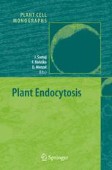Search
Search Results
-
Dynamin-Related Proteins in Plant Endocytosis
Over the past decade, it has become evident that multiple endocytic pathways operate in eukaryotic cells, and several of these are dependent on...
-
Molecular Dissection of the Clathrin-Endocytosis Machinery in Plants
In the last few years, the endocytic vesicular uptake in plant cells has gained increasing significance in several physiological processes....
-
Receptor-Mediated Endocytosis in Plants
Binding of ligands activates cell-surface receptors and triggers a series of signalling events. The activation of the receptors accelerates their...
-
Endocytosis and Endosymbiosis
Symbioses are widespread in nature and occur between organisms that belong to a large variety of taxonomic divisions (Hentschel et al. 2000). Most...
-
Endocytic Uptake of Nutrients, Cell Wall Molecules and Fluidized Cell Wall Portions into Heterotrophic Plant Cells
After arrival at the surface of heterotrophic cells, nutrients are taken up by these cells via endocytosis to sustain metabolic processes. Recent...
-
Algae Cultivation Systems
Algae are a diverse group of micro- and macroscopic, highly efficient photosynthetic organisms with rapid growth and flourish in a variety of...
-
Omics Approaches for Algal Applications
Algae grow faster due to their higher photosynthetic efficiency than terrestrial plants, making them more productive. Assimilating carbon dioxide and...
-
Algae as a Functional Food: A Case Study on Spirulina
Spirulina (Arthrospira spp.) is a blue-green microalga within the phylum Cyanophyta, also known as Cyanobacteria. It has superior nutritional value,...
-
Wheat Chromosomal Resources and Their Role in Wheat Research
Bread wheat (Triticum aestivum L.) is grown on more area of land than any other crop, and its global significance is challenged only by rice. Despite...
-
Ancient Wheat Genomes Illuminate Domestication, Dispersal, and Diversity
Ancient DNA (aDNA) promises to revolutionise our understanding of crop evolution. Wheat has been a major crop for millennia and has a particularly...
-
Rapid Cloning of Disease Resistance Genes in Wheat
Wheat is challenged by rapidly evolving pathogen populations, resulting in yield losses. Plants use innate immune systems involving the recognition...
-
The Wheat Transcriptome and Discovery of Functional Gene Networks
Gene expression patterns have been a widely applied source of information to start understanding gene function in multiple plant species. In wheat,...
-
Pädiatrische Krebserkrankungen
Obwohl Krebserkrankungen bei Kindern und Jugendlichen insgesamt selten sind, treten einige Krebsarten überwiegend bei Kindern und Jugendlichen auf....
-
Harnblasenkrebs
Die meisten Krebserkrankungen in der Harnblase sind Urothelkarzinome (UC). Sie werden hauptsächlich durch chemische Karzinogene, speziell durch...
-
Magenkrebs
Magenkrebs bleibt weltweit eine häufige Ursache für Krebstodesfälle, doch seine Inzidenz ist in den meisten Ländern seit mehreren Jahrzehnten stark...
-
Brustkrebs
Brustkrebs (Mammakarzinom) ist eine der Haupttodesursachen bei Frauen, vergleichbar mit Lungen- und Darmkrebs. Ein Thema in diesem Kapitel sind die...
-
Invasion und Metastasierung
Dieses Kapitel beschreibt Prozesse, Moleküle und Wechselwirkungen, die zur Invasion und Metastasierung beitragen, die am stärksten definierenden...
-
Krebsepigenetik
Epigenetische Mechanismen etablieren zellspezifische Genexpressionsmuster, die stabil über Zellteilungen hinweg übertragen werden. Epigenetische...
-
Krebstherapie
Die aktuelle Krebstherapie basiert auf Chirurgie, Strahlentherapie, Chemotherapie und Immuntherapie, die oft in verschiedenen Kombination miteinander...
-
Darmkrebs
Karzinome des Dick- und Enddarms (KolorektalKarzinome, CRC) gehören weltweit zu den am häufigsten auftretenden Krebsarten. Kolorektalkarzinome...
